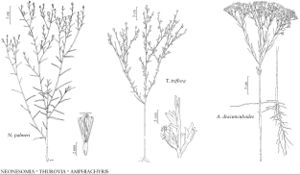Neonesomia palmeri
Sida 21: 253. 2004.
Common names: Texas desert goldenrod Texas goldenweed
Basionym: Aster palmeri A. Gray
Synonyms: Ericameria austrotexana M. C. JohnstonXylothamia palmeri (A. Gray) G. L. Nesom
Revision as of 00:34, 27 July 2019 by FNA>Volume Importer
Stems: bark tan, becoming brown to gray; twigs mostly green, prominently ridged. Leaves moderately crowded; blades spreading, 10–30 × 1–2 mm, plane; axillary fascicles rarely present. Phyllaries 1.5–5.2 × 0.8–1.2 mm, midveins enlarged near apex, resin gland and surrounding tissue evident as green to brown patches. Ray laminae 2.5–3 × 0.5–1 mm. Disc corollas 3.8–5.5 mm, tubes glabrous, lobes unequal, 1–2.7 mm; style branches 1.5–2.2 mm, appendages 0.7–1.1 mm. Cypselae 1.5–2 mm; pappi 3.7–5.3 mm. 2n = 18.
Phenology: Flowering fall.
Habitat: Associated with brushy vegetation, brushy pastures, saline flats, coastal dunes
Elevation: 0–600 m
Distribution

Tex., Mexico (Nuevo León, Tamaulipas).
Discussion
Neonesomia palmeri grows on open flats to steep slopes in saline to sandy habitats in southern Texas.
Selected References
None.
Lower Taxa
None.
